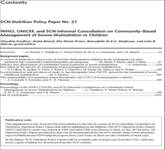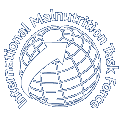
In these pages you will find policy documents. These may be international policies developed by international agencies, or national policies created by governments to guide in-country treatment and prevention of malnutrition.
If your country has a national policy that is not included here, please email us.
SCN Policy Document 21 on Commmunity Based Management of Severe Acute Malnutrition

A meeting of experts was organized by the Department of Child and Adolescent Health and Development and the Department of Nutrition for Health and Development of the WHO, by UNICEF and the UN Standing committee on Nutrition in Geneva on 21-23rd November 2005 to provide recommendations for Community-Based Management of Severe Malnutrition in Children resulting in the SCN Policy Paper No. 21.
Severe malnutrition, defined by severe wasting (weight-for-height < –3 z-scores or < 70% of the median. National Centre for Health Statistics/World Health Organization [NCHS/WHO] reference) and/or the presence of nutritional edema, is a life-threatening condition requiring urgent treatment. How many lives would better treatment of severe child malnutrition save? The prevalence of severe malnutrition is estimated as around 2% in the least-developed countries and 1% in other developing countries, which translates to about 10 million severely malnourished children at one time. About 10 million children under five die each year. Some 4 million of these are neonatal deaths, which are not generally preventable by addressing severe malnutrition, but a significant proportion of the remaining 6 million may be preventable in this way.
The recommendations included Ready-to-use therapeutic Foods (RUTF) developed to allow community based management of large numbers of children who are severely malnourished without medical complications. The RUTFs are in the form of energy-dense pastes or biscuits containing no water so they would not support bacterial growth (which is a major drawback of milk-based liquid diets). These were shown to be efficacious in producing rapid weight gain and they can be used in the community. This combination of safer therapeutic foods and their feasible use in the home has begun to transform the way severe malnutrition is managed in the community in both emergency and nonemergency settings.
The full policy document can be accessed here.
Protocol for the Management of Severe Acute Malnutrition – Ethiopia

This document outlines the steps and procedures for treating a severely malnourished patient in a
Therapeutic Feeding Unit (TFU, hospital or in the community. It is presented in 2 major sections. The
first part deals with the age group from six months old to adulthood. The treatment for the infants less
than 6 months old has major differences and is presented separately. It revises the May 2004 Guideline
for the Management of Severe Acute Malnutrition
Interim Guidelines for the Management of Acute Malnutrition in Adolescents and Adults- Malawi
The guidelines provide clear protocols for effective treatment of
acute malnutrition which can easily be followed by Health workers and other
service providers in provision of outpatient and in patient care to the clients.
